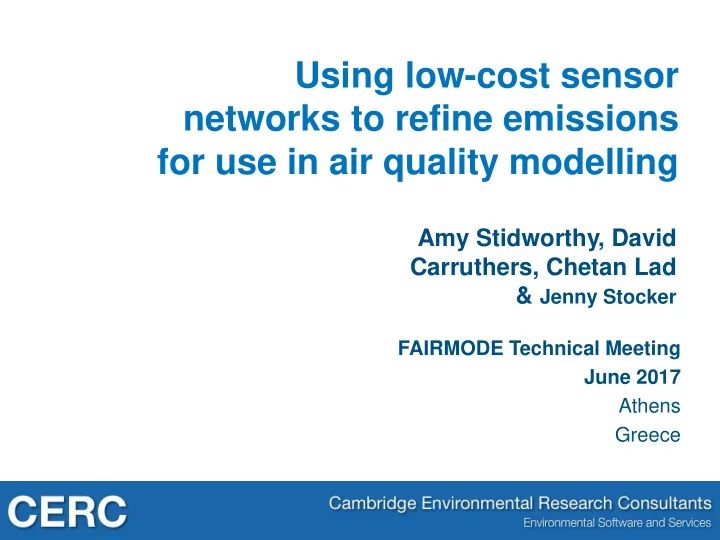

Using low-cost sensor networks to refine emissions for use in air quality modelling Amy Stidworthy, David Carruthers, Chetan Lad & Jenny Stocker FAIRMODE Technical Meeting June 2017 Athens Greece
Contents • Positive and negative aspects of sensors • Methodology for using sensors to optimise AQ modelling results – Cambridge pilot study • Using sensors to optimise aircraft emissions indices for use in AQ modelling at Heathrow Airport • Summary FAIRMODE 2017
Positive and negative aspects of sensors Traditional measurement Low cost sensors techniques Cost Variable, but generally low High Less reliable & generally less Accuracy Reliable & usually accurate accurate Spatial High & possibilities for indoor Low resolution & outdoor measurements Suitable for personal Measurements may not be Human representative of people’s exposure measurements i.e. exposure people carry them exposure • What do they have in common? − Record O 3 , CO, NO, NO 2 , SO 2 , CO 2 , total VOCs and PM − Use different techniques for gaseous and particulate pollutants − Require calibration metal oxide or optical detection Sensor electrochemical and other techniques sensing methods FAIRMODE 2017
Using sensors to optimise AQ modelling results 1 RUN 1 : local AQ model Sensor monitored (ADMS-Urban) with concentration data standard emissions Monitor data error : systematic (e.g. temperature dependence) + Apply inversion technique # to unsystematic (e.g. faults) calculate adjusted Emissions data error : systematic emissions + (e.g. emission factors) + unsystematic (e.g. driving behaviour) RUN 2 : local AQ model Restrictions : (ADMS-Urban) with • Inversion technique requires model concentration to be adjusted emissions proportional to the emissions, so complex effects like local chemistry have to be ignored in RUN 1 • Sources included must influence at least one sensor Evaluate against reference monitors • Sensors included must have non- zero ‘traffic concentration’ # Probabilistic approach following work by others, e.g. Webster et al, 2016 T T 1 1 + x Mx y R Mx y x e B x e - refer to full presentation (link on last slide) J FAIRMODE 2017
Using sensors to optimise AQ modelling results 2 • Preliminary results: Cambridge – CERC have been collaborating % on a project to study ambient air quality across Cambridge using a large number of sensor nodes and computer modelling. – 20 AQMesh sensor pods have been placed at key points around Cambridge, measuring air quality in near real time. – 5 reference monitors % University of Cambridge, Cambridge FAIRMODE 2017 City & County Council, AQMesh
Effect of optimisation on model validation 1. Base Frequency scatter plot: hourly NOx, reference monitors only Base case model output 2. All monitors 1. Base 2. All monitors Model output using optimised emissions; optimisation carried out using all sensor data Data points not included in the 3. Sensor network only inversion Modelled concentrations Model output using optimised emissions; optimisation carried out using AQMesh data only Statistics 1. 2. 3. 3. Sensor Obs 31.2 31.2 31.2 network only Validation at Mean Mod 34.5 29.3 31.3 reference Obs 27.9 27.9 27.9 sites only StDev Mod 31.0 26.0 27.0 MB 3.30 -1.91 0.10 NMSE 0.51 0.05 0.39 R 0.70 0.97 0.75 Observed concentrations Fac2 0.71 0.94 0.73 FAIRMODE 2017
Using sensors to refine modelling at Heathrow Airport • University of Cambridge & CERC, funded by NERC & EPSRC, working with Heathrow Airport Ltd • 17 sensors deployed at Heathrow Airport, 5-week period • Results: – Sensors are able to distinguish airport emissions from long range transport, leading to: • Refinement of aircraft activity emissions (using ratios of sensor measurements to CO 2 ) • Quantification of the relative importance of aircraft emissions & road traffic emissions – Improved emissions used in modelling (ADMS-Airport) leads to very good agreement with measurements • Methodology can be used for other applications e.g. traffic FAIRMODE 2017
Summary • Low-cost sensors may (or may not) have reliability issues, but when deployed as networks, they can be used to: − Improve emissions calculated using ‘standard’ emission factor datasets − Identify the contribution of local sources compared to long-range transport Link to full presentation on model optimisation using sensor data: https://www.slideshare.net/ies-uk/amy-stidworthy-optimising-local-air- quality-models-with-sensor-data?qid=bf79a79b-24b8-47b0-9d51- 41f8fdb69019&v=&b=&from_search=3 FAIRMODE 2017
Extra slides FAIRMODE 2017
Using sensors to optimise AQ modelling results 3 Regent St Parker St Evaluation against reference Gonville Place Montague Rd monitors: 5 th July 2016 • Preliminary tests: currently sensors only located close to roads, and only modelling road sources • Success: works at reference locations FAIRMODE 2017
Recommend
More recommend